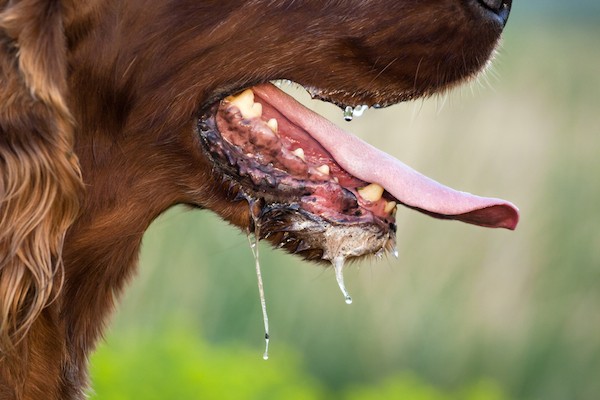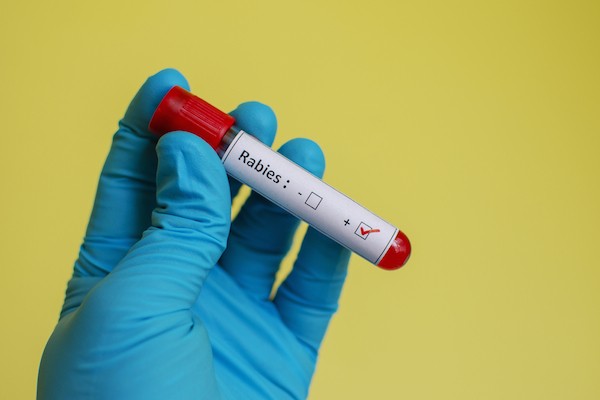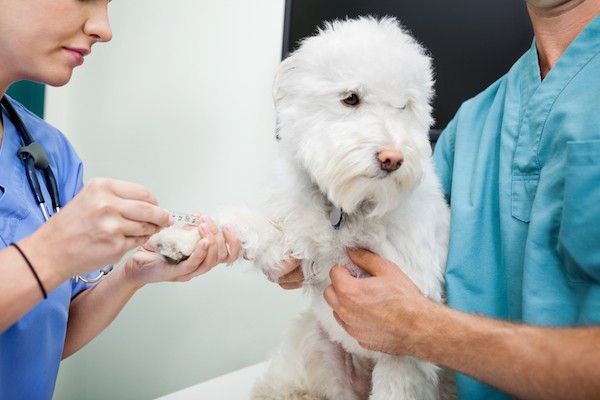Editor’s note: Have you seen the new Dogster print magazine in stores? Or in the waiting room of your vet’s office? This article appeared in our June/July issue. Subscribe to Dogster and get the bimonthly magazine delivered to your home.
Most dog owners typically know three things about rabies: Dogs require a rabies vaccine by law, rabies causes frothing at the mouth, and people with rabies can experience hydrophobia (extreme fear of water). Those are scant few facts about one of the deadliest viruses in the world, considering that rabies still occurs in the United States and many other countries around the globe. There is no known cure for rabies, and symptoms can begin many months after an infected animal bites the victim.

W. Jean Dodds, D.V.M., president of Hemopet in Santa Monica, California, has been researching the rabies vaccine in dogs for many years and is a co-trustee of the Rabies Challenge Fund, an organization focused on rabies immunity research. The Rabies Challenge Fund hopes to one day provide proof that immunity from the rabies vaccine lasts five to seven years, evidence that may change current rabies vaccination laws, avoiding revaccination and its possible adverse affects. I spoke to Dr. Dodds about her research and about what you must know about the rabies vaccine and your dog.
Nikki Moustaki for Dogster: You have been integral in changing the way veterinarians and dog owners think about the rabies vaccine. What made you interested in tackling this issue?
Dr. Dodds: I have had a long-standing — more than 40 years — interest in vaccines, vaccine efficacy, and vaccine safety issues. Rabies vaccines are among the strongest immune-stimulating vaccines, as they are killed-virus products that contain powerful adjuvants (substances that enhance the body’s immune response to an antigen), and all but one currently licensed rabies vaccine contains mercury (thimerosal) preservative, which is known to induce autoimmune and other immunological adverse effects. That said, rabies is a fatal disease of all mammals, including humans, and is the reason that rabies vaccination is legally mandated.
What’s the difference between the one-year rabies vaccine and the three-year vaccine?
The one-year and three-year rabies vaccines are essentially the same product, just labeled differently to distinguish that fact that the dog has received just the one-year dose and still needs the follow-up three-year dose a year later.
Why do you personally recommend the three-year rabies vaccine?
First, because the law requires it, and second, because some dogs are not adequately immunized or protected by just one rabies vaccine, so all dogs are required to have two doses initially, given within 12 months. After that, boosters are legally required every three years.

What can happen with “over-vaccination”?
Over-vaccination with any vaccine, including rabies vaccine, can cause a variety of clinical symptoms, including seizures; behavioral changes; auto-immune destruction of the blood cells, liver, joints, and skin; as well as various other signs of what is termed “vaccinosis.”
What can happen if people don’t vaccinate their dogs at all?
Failure to vaccinate is foolhardy. The chances of a dog, other companion animal, livestock, poultry, pet birds, or even exotic pets and zoo animals contracting the prevalent infectious diseases of their species is high, and so these unprotected animals are at risk of illness, even death. Failure to give rabies vaccines as legally required is a misdemeanor and can lead to quarantine of the animal and even a jail term for the pet guardian.
What is the current rabies vaccine protocol?
All dogs are legally required to have two rabies vaccines within 12 months. Rabies vaccines are not to be given before 12 weeks of age and must be given by 6 months of age, although the age at which the first one is to be given within these parameters varies with the individual state, county, or city where the animal lives.
When should dog owners opt for a rabies titer (blood test to evaluate immunity) rather than a vaccine?
Rabies titers are typically used for exporting an animal to another country that is rabies-free. Within the USA, rabies titers are used to prove that a dog has been adequately immunized against rabies, which can be needed for a variety of medical or legal reasons, including the written justification for a medical exemption from the rabies booster vaccination because of serious illness or prior life-threatening rabies vaccine reaction. Rabies titers are not legally accepted in any state in lieu of rabies booster requirements, except in specific case-by-case medical justifications. Even then, exemptions are not uniformly permitted and are discouraged.

Why do you believe that the current rabies vaccine laws need to change, and what would those laws ideally look like?
The current rabies laws need to be uniform throughout the country and be less ambiguous. Rabies titer serology should be considered on a case-by-case basis in lieu of automatic rabies boosters when justified by the primary care veterinarian.
Rabies policies should take into account the documented number of rabies cases in the area (in mammals other than bats) and the prior rabies vaccination history for the pet; they should also provide options for veterinarians when justified on a case-by-case basis to offer rabies titers in lieu of booster vaccines for very elderly patients. In geriatric pets, many are in a compensatory state with regard to age-related conditions; rabies boosters may aggravate their underlying health status and should not be needed if rabies titer levels were at or above the amount stated by the CDC to be acceptable to protect a person from rabies (0.1 IU/ml).
For more information about rabies and Dr. Dodds’ ongoing research about the duration of rabies immunity, visit the Rabies Challenge Fund. These studies are conducted in collaboration with Dr. Ronald Schultz of the University of Wisconsin School of Veterinary Medicine in Madison, Wisconsin.
Read more about rabies:
- How Do Dogs Get Rabies?
- Ask a Vet: Is a Dog’s Voice Changing a Symptom of Rabies?
- What Are Titers? Can They Show What Vaccinations a Dog Needs?
About the author: Nikki Moustaki is a dog trainer, dog rescuer, and pet expert. She splits her time between New York City and Miami Beach, Florida, and is the author of the memoir The Bird Market of Paris.





